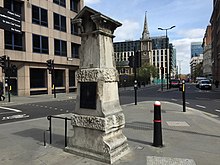Aldgate Pump is a historic former water pump located at the junction where Aldgate High Street meets Fenchurch Street and Leadenhall Street in the City of London. The pump is considered to be the symbolic start point of the East End of London.

The pump is also notable for its long and sometimes dark history, along with its significant cultural references.
Design
editAldgate Pump is a Grade II listed structure.[1] The metal wolf head on the pump's spout is supposed to signify the last wolf shot in the City of London.[2]
Historic photographs show that the pump was surmounted by an ornate wrought iron lantern. During the 20th century this was removed, but was recreated by the Bottega Prata workshop in Bologna, Italy, during its restoration by the Heritage of London Trust, unveiled in September 2019.[3] The pump can no longer be used to draw water, but a drainage grating is still in place.
History
editAs a well, it was mentioned during the reign of King John in the early 13th century.[4]
A structure is shown on Braun and Hogenburg's map of 1574, and shown as St Michael’s Well on the Agas map of 1633. John Stow recalled the execution of the Bailiff of Romford on a gibbet 'near the well within Aldgate'.[5] This execution seems to have been carried out on the dubious basis that he was involved in Kett's Rebellion of 1549.[6]
Served by one of London's many underground streams, the water was praised for being "bright, sparkling, and cool, and of an agreeable taste".[7] These qualities were later found to be derived from decaying organic matter from adjoining graveyards,[7] and the leaching of calcium from the bones of the dead in many new cemeteries in north London through which the stream ran from Hampstead.[8] On its relocation in 1876, the New River Company changed the supplies to mains water.
Fenchurch Street railway station was built in 1841 upon the site of Aldgate Pump Court.[9]
As the City of London developed, it is thought to have been taken down and moved a short distance to the west, to its current location in 1876, as a result of road widening.[4]
East End
editThe line of the former eastern walls and gates of the City are taken as the usual start point of the East End, but the pump lies just inside the site of the former Aldgate. The pump is a suitable symbolic start point for several reasons:
- The removal of the gate and associated walls in the late 18th century[5] gave the pump added significance.
- The social importance of pumps as meeting places
- The pump marks the start of the originally Roman A11 road, later known as the Great Essex Road. Distances to locations in the Tower division of Middlesex, Essex and East Anglia were measured from here.
Cultural references
editPhrases
editEast of Aldgate Pump is a term used to apply to the East End or East London as a whole, as in the old slur "East of Aldgate Pump, people cared for nothing but drink, vice and crime".[10] It is also used in two phrases which seem to hark back to the epidemic:
- As Cockney Rhyming Slang; Aldgate Pump, or just Aldgate for short, rhymes with “get (or take) the hump”, i.e. to be annoyed.
- A draft on Aldgate Pump refers to a harmful, worthless or fraudulent financial transaction, such as a bouncing cheque. The pun is on a draught (or draft) of water and a draft of money.[11]
- There's a pump up Aldgate, mate. Pump that! was an East End phrase directed at rent collectors believed to be pressing tenants unreasonably hard.
Music, TV and literature
editCharles Dickens refers to the pump in The Uncommercial Traveller, published in 1860: "My day's no-business beckoning me to the East End of London. I had turned my face to that point of the metropolitan compass…and had got past Aldgate Pump."[12]
Aldgate Pump was also the name of a song, written by G. W. Hunt for the lion comique Arthur Lloyd in 1869. In the song, the raconteur is abandoned by the girl "I met near Aldgate Pump".[13]
References
edit- ^ Historic England. "Details from listed building database (1064733)". National Heritage List for England. Retrieved 14 September 2009.
- ^ "The English-speaking World: Incorporating the Landmark". English-Speaking Union. 29 April 1932. Archived from the original on 22 May 2022. Retrieved 21 September 2020 – via Google Books.
- ^ "Aldgate Pump | the story behind the City of London's historic water pump". 9 June 2022.
- ^ Jump up to: a b Aldermary Churchyard – Aldgate Ward Archived 4 June 2011 at the Wayback Machine, A Dictionary of London (1918). accessed 14 September 2009
- ^ Jump up to: a b The London Encyclopaedia, Weinreb and Hibbert
- ^ Romford Recorder article looking at the execution https://www.romfordrecorder.co.uk/news/heritage/romford-history-shock-as-bailiff-was-hanged-under-martial-law-1-5116417 Archived 2 August 2019 at the Wayback Machine
- ^ Jump up to: a b Britain), Institution of Civil Engineers (Great (29 April 1868). "Minutes of Proceedings of the Institution of Civil Engineers". The Institution. Archived from the original on 22 May 2022. Retrieved 21 September 2020 – via Google Books.
- ^ "Aldgate Pump. Part of the Secret London series by Historic UK". Historic UK. Archived from the original on 24 September 2020. Retrieved 29 April 2019.
- ^ Aldgate Ward School – All Hallows Garschirch, Gracechurch, Grascherch, in Gracioustreete Archived 19 August 2011 at the Wayback Machine, A Dictionary of London (1918). accessed 14 September 2009
- ^ Hoping to find the original source http://spitalfieldslife.com/2019/07/11/at-aldgate-pump/ Archived 12 July 2019 at the Wayback Machine
- ^ Brewers dictionary of phrase and fable ) https://www.bartleby.com/81/5319.html Archived 2 August 2019 at the Wayback Machine
- ^ Charles Dickens, The Uncommercial Traveller, Chapter 3, "Wapping Workhouse".
- ^ Arthur Lloyd's "Aldgate pump" Archived 7 September 2008 at the Wayback Machine (Arthur Lloyd music hall history) accessed 14 September 2009
